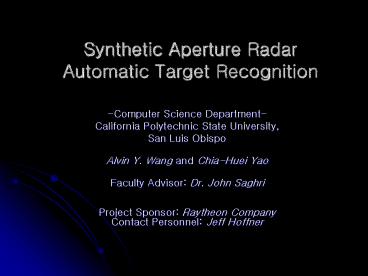Synthetic Aperture Radar Automatic Target Recognition - PowerPoint PPT Presentation
Title:
Synthetic Aperture Radar Automatic Target Recognition
Description:
Title: SAR ATR with the TPS Author: Shih Mei Chang Last modified by: Yao Created Date: 2/18/2003 11:09:26 PM Document presentation format: – PowerPoint PPT presentation
Number of Views:78
Avg rating:3.0/5.0
Title: Synthetic Aperture Radar Automatic Target Recognition
1
Synthetic Aperture Radar Automatic Target
Recognition
- -Computer Science Department-
- California Polytechnic State University,
- San Luis Obispo
- Alvin Y. Wang and Chia-Huei Yao
- Faculty Advisor Dr. John SaghriProject
Sponsor Raytheon CompanyContact Personnel Jeff
Hoffner
2
Agenda
- Introduction
- Automatic Target Recognition
- Synthetic Aperture Radar
- Problem and Proposed Solutions
- Feature Extraction
- Image Matching
- Conclusion
3
Introduction
- Usage of image identification
- Military
- Medical
- SAR images
- MSTAR image database
Courtesy of Sandia National Laboratory
4
Synthetic Aperture Radar
- SAR instruments use pulses of microwaves as an
active source of illumination - Benefits
- Independent of light sources
- Capable to see through clouds
- Spatial resolution remains the same no matter
how far the target area is
5
Automated Target Recognition
- Five Stages
- Feature Extraction Detection
- Feature Enhancement - Discrimination
- Image Matching Classification, Recognition,
Identification
6
Problem and Proposed Solutions
- Traditional ATR algorithms
- Problem Removal of useful target information
- Solution Multi-feature ATR techniques
- Feature Extraction
- Edge Detection, Topographical Primal Sketch
- Image Matching
- Hausdorff Distance Transform
7
Feature Extraction
- Feature Detection
- Edge Detection Sobel Mask
- Line Detection Laplacian Mask
- Topographical Primal Sketch
- Multiple-feature consideration
8
WaitBefore Feature Detection
- Reject Noise
- The target images are full of noise
- Median filter
9
Edge Detection
- The box provides little clue for identification
- Even worse, the edges are affected by different
illuminating status and orientation
10
Topographical Primal Sketch
- The light intensity variations on an image are
caused by an objects surface orientation, its
reflectance, and characteristics of its lighting
source - Based on the variance of light intensity, we can
classify and group the underlying image into some
topographical categories
11
- Topographical categories includes peak, pit,
ridge, ravine, saddle, flat, hillside, etc. - Based on the location of the topographical
features, we can reasonably reconstruct the
original 3D model.
12
Feature Extraction and Distance Transform
Edge
Feature Extraction
Distance Transform
Original Image
Peak
Ridge
13
Image Matching
- Database
- Model templates
- Problems
- Scale
- Rotation
- Partially obstructed images
- Distance Transform
14
Image Matching procedure
- Find contour points of the reference shape and
obtain their DT - Obtain contour points of the measured shape
- Compute and superimpose the centroids of the two
point sets - Rotate and translate the measured point set with
respect to the initial pose - Select those relative positions that yield the
minimum HD value - Select the one with the least mean HD.
15
Hausdorff Distance Transform
- h(A,B) max min d(a,b)
- H(A,B) max h(A,B), h(B,A)
16
Hausdorff Distance Illustration
a2
h(A,B)
h(B,A)
H(A,B)
Hausdorff Distance provides a measure of set A
and set Bs proximity it indicates the maximal
distance between any points of A to B.
17
Chamfer Distance Transform
- CDT Provides good approximation to the exact
Euclidean distance - Distance Trasform converts a binary image to
another image in which pixel value is the
distance from this pixel to the nearest nonzero
pixel of the binary image.
courtesy of IPAN
18
Image Matching procedure
19
Image Matching procedure
- Find contour points of the reference shape and
obtain their DT - Obtain contour points of the measured shape
- Compute and superimpose the centroids of the two
point sets - Rotate and translate the measured point set with
respect to the initial pose - Select those relative positions that yield the
minimum HD value - Select the one with the least mean HD.
20
An image (left) and its distance transform (right)
Test image and Target detected when the contours
are superimposed
courtesy of IPAN
21
Template image
Test image
Target detected
courtesy of Cornell Vision Group
22
Conclusion
- Current Progress and Future Directions
- Feature Extraction
- Feature detection
- TPS
- Image Matching
- Hausdorff Distance Transform
- Testing
- Database
- Actual Matching with test images
23
References
- Image and Pattern Analysis Group
http//visual.ipan.sztaki.hu/ - Cornell Computer Vision Grouphttp//www.cs.cornel
l.edu/vision - Robert M. Haralick, Layne T. Watson, Thomas J.
Laffey, The Topographic Primal Sketch. The
international Journal of Robotics Research. Vol.
2, No. 1, Spring 1983
24
Thank You
- Questions and Comments
- Visit our web page Alvin www.csc.calpoly.edu/ay
wang - Huey www.calpoly.edu/cyao































